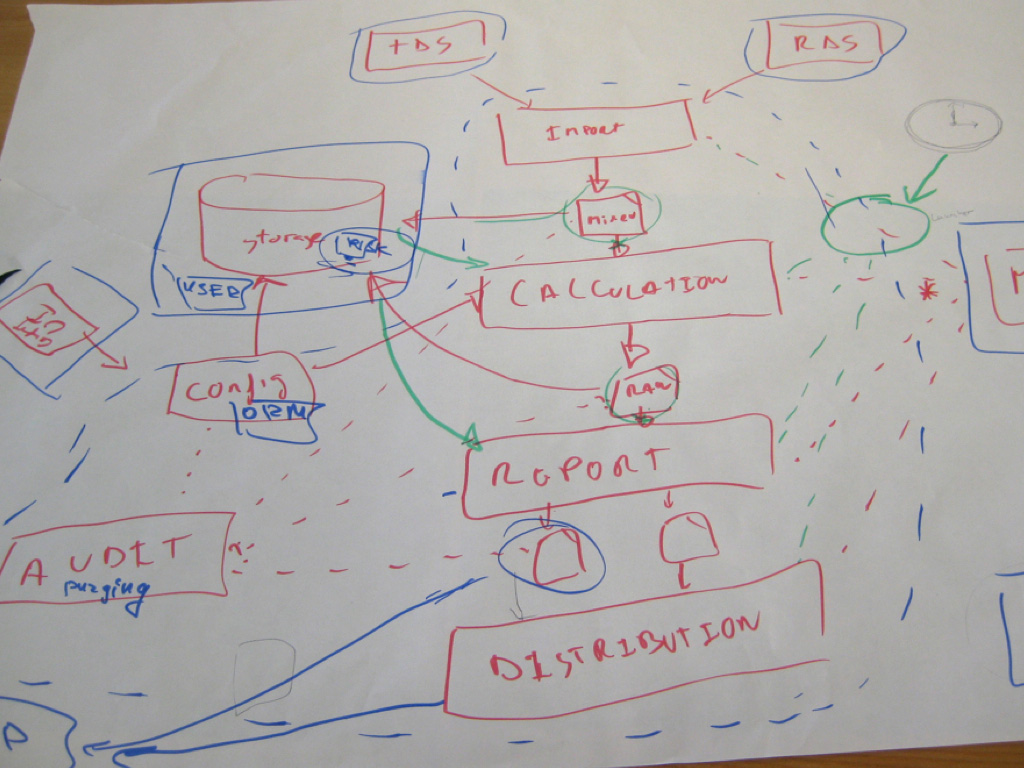
1. A set of hierarchical abstractions (software systems, containers, components, and code).
2. A set of hierarchical diagrams (system context, containers, components, and code).
3. Notation independent.
4. Tooling independent.
The C4 model is an easy to learn, developer friendly approach to software architecture diagramming. Good software architecture diagrams assist with communication inside/outside of software development/product teams, efficient onboarding of new staff, architecture reviews/evaluations, risk identification (e.g. risk-storming), threat modelling, etc.
Ask somebody in the building industry to visually communicate the architecture of a building and you'll be presented with site plans, floor plans, elevation views, cross-section views and detail drawings. In contrast, ask a software developer to communicate the software architecture of a software system using diagrams and you'll likely get a confused mess of boxes and lines . inconsistent notation (colour coding, shapes, line styles, etc), ambiguous naming, unlabelled relationships, generic terminology, missing technology choices, mixed abstractions, etc.


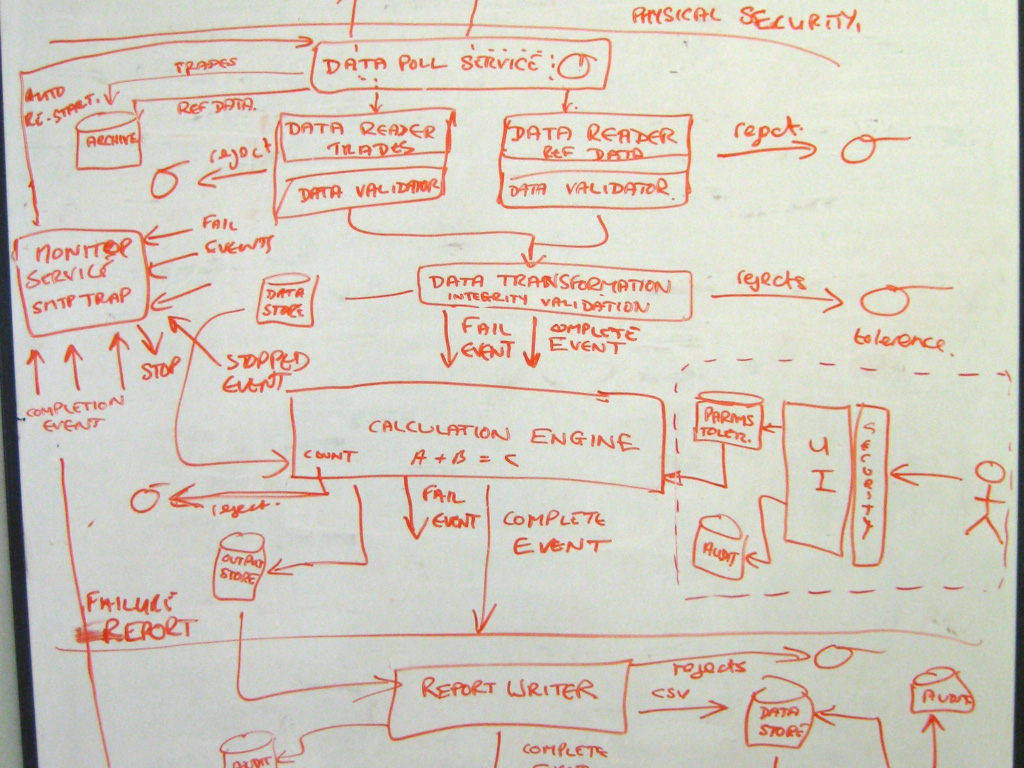
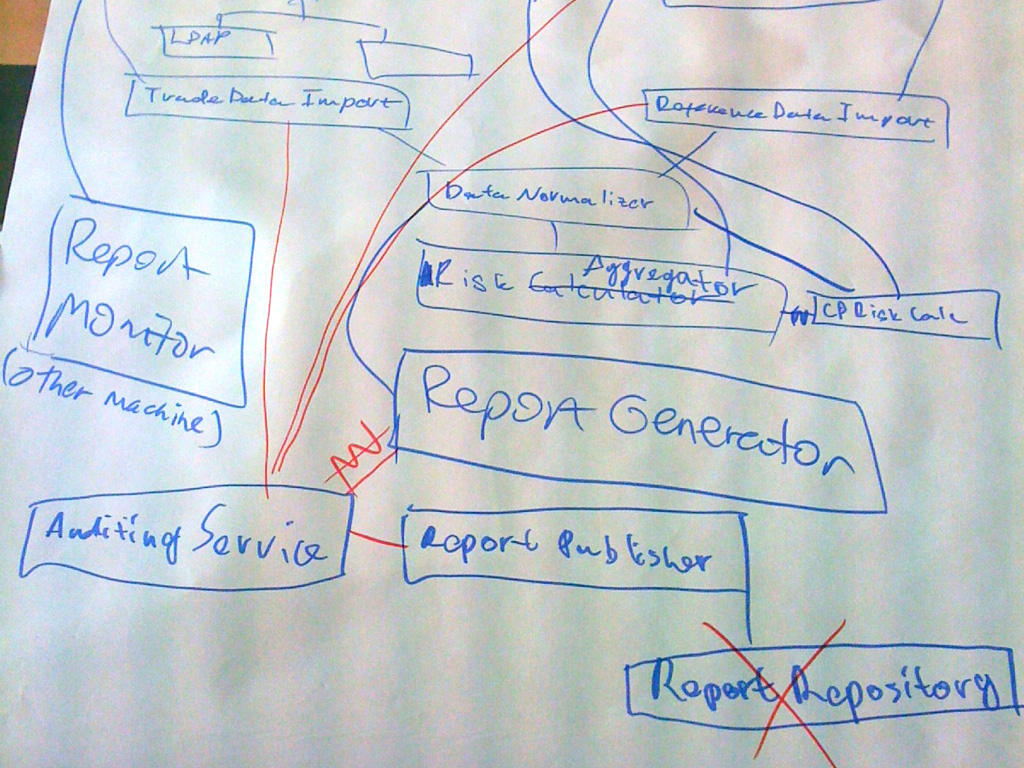
As an industry, we do have the Unified Modeling Language (UML), ArchiMate and SysML, but asking whether these provide an effective way to communicate software architecture is often irrelevant because many teams have already thrown them out in favour of much simpler "boxes and lines" diagrams. Abandoning these modelling languages is one thing but, perhaps in the race for agility, many software development teams have lost the ability to communicate visually.
The C4 model was created as a way to help software development teams describe and communicate software architecture, both during up-front design sessions and when retrospectively documenting an existing codebase. It's a way to create maps of your code, at various levels of detail, in the same way you would use something like Google Maps to zoom in and out of an area you are interested in.
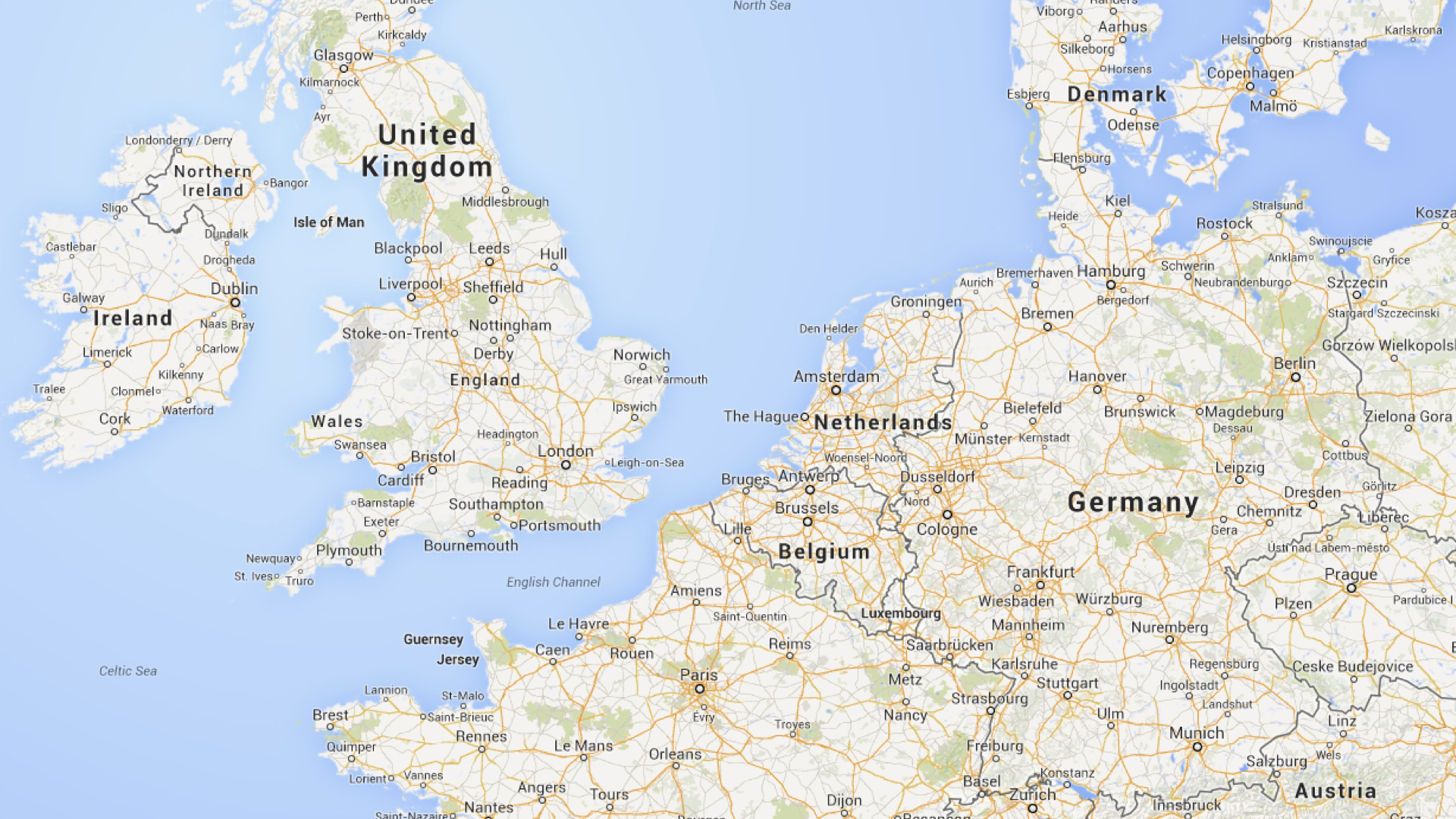
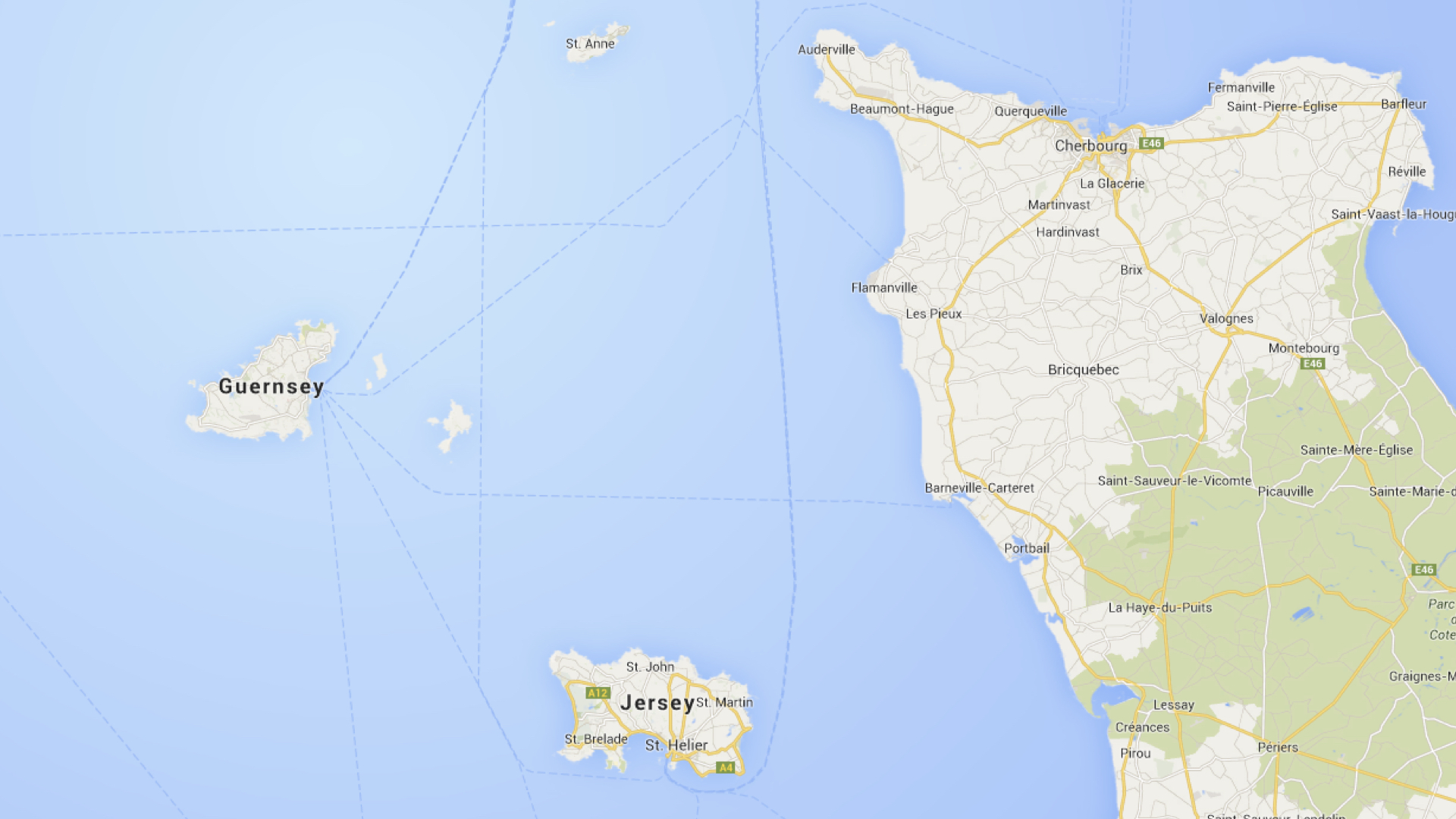
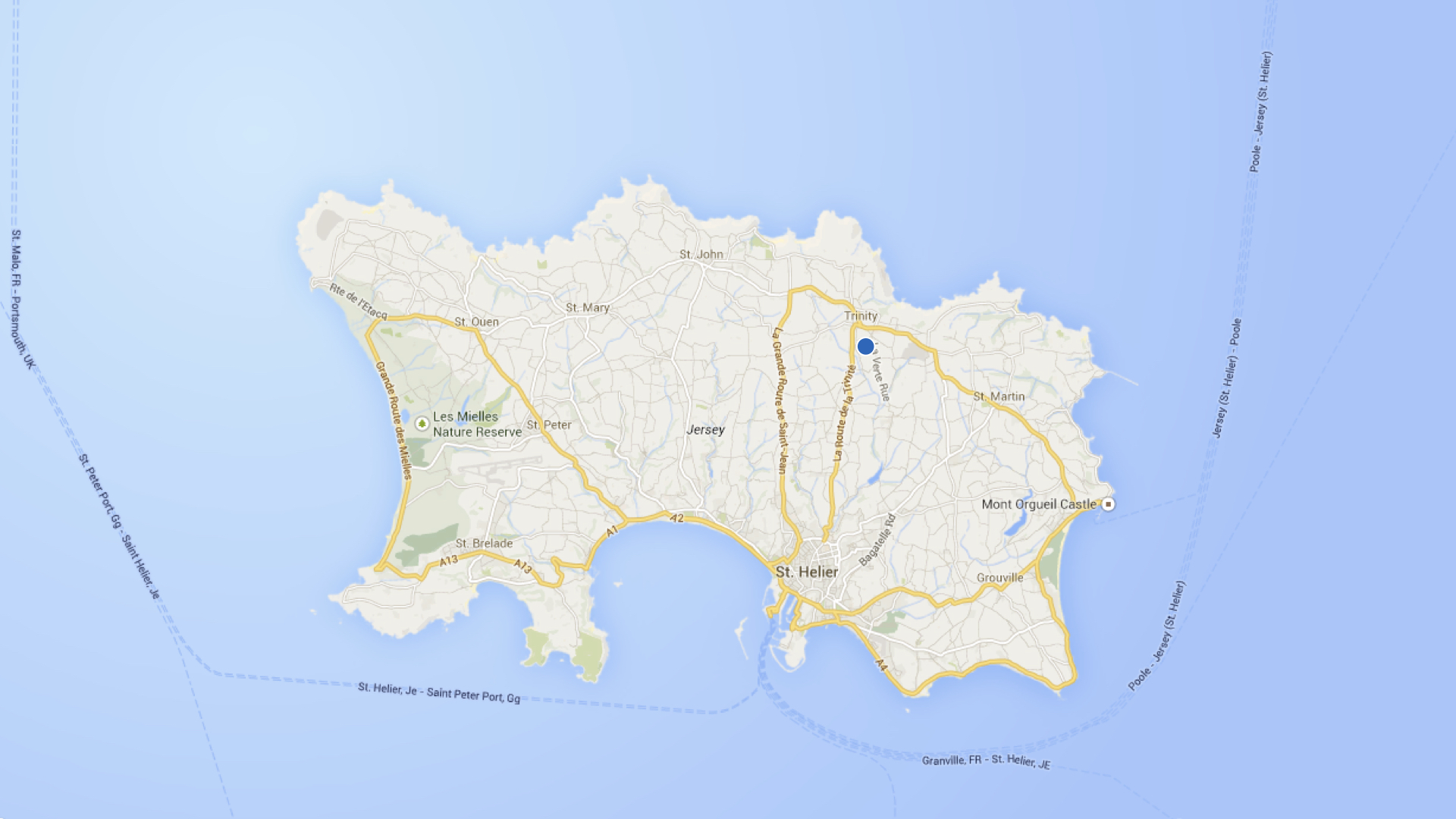
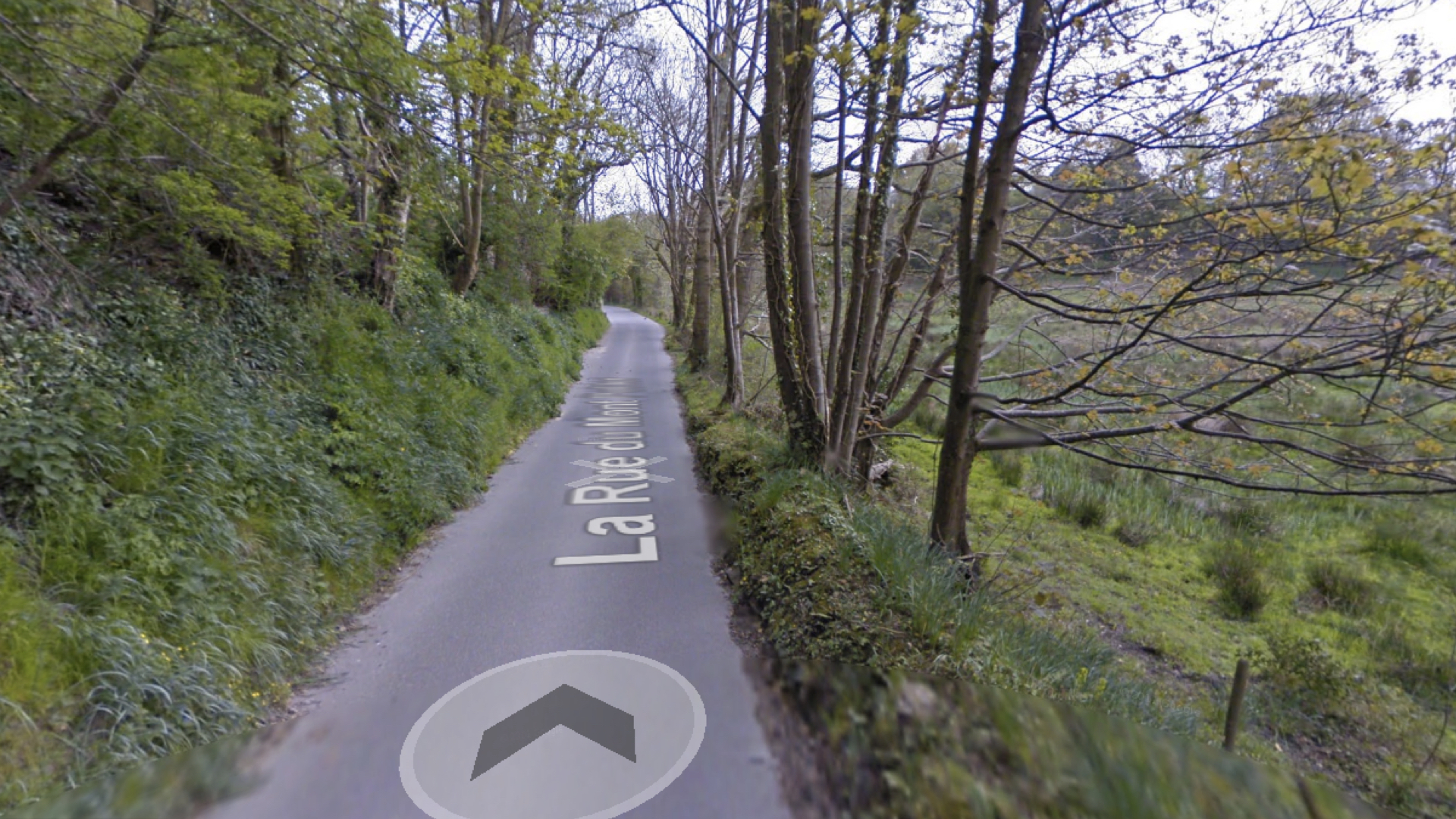

Level 1: A System Context diagram provides a starting point, showing how the software system in scope fits into the world around it.

Level 2: A Container diagram zooms into the software system in scope, showing the high-level technical building blocks.

Level 3: A Component diagram zooms into an individual container, showing the components inside it.
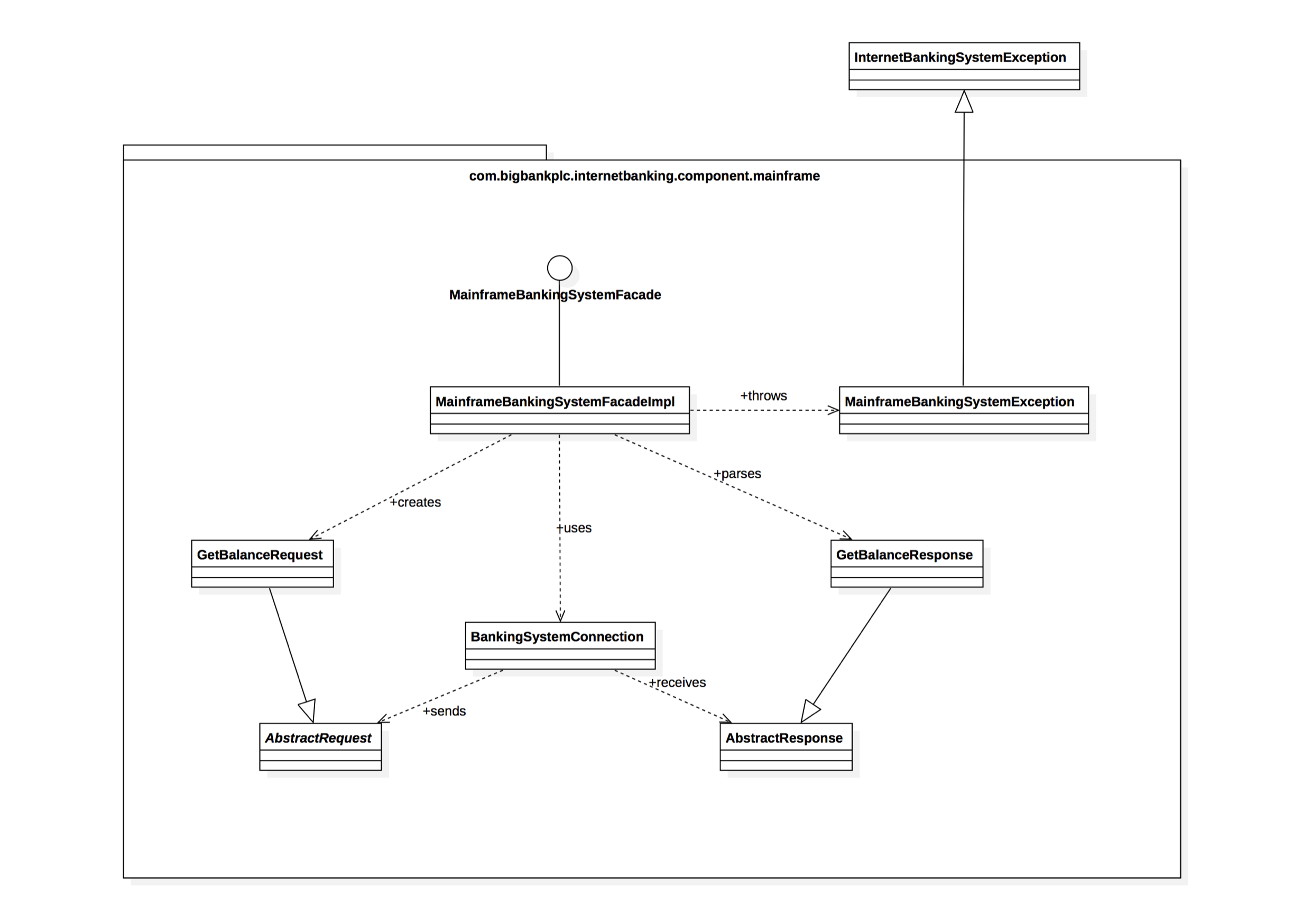
Level 4: A code (e.g. UML class) diagram can be used to zoom into an individual component, showing how that component is implemented.
The C4 model is an "abstraction-first" approach to diagramming software architecture, based upon abstractions that reflect how software architects and developers think about and build software. The small set of abstractions and diagram types makes the C4 model easy to learn and use. Please note that you don't need to use all 4 levels of diagram; only those that add value - the System Context and Container diagrams are sufficient for many software development teams.
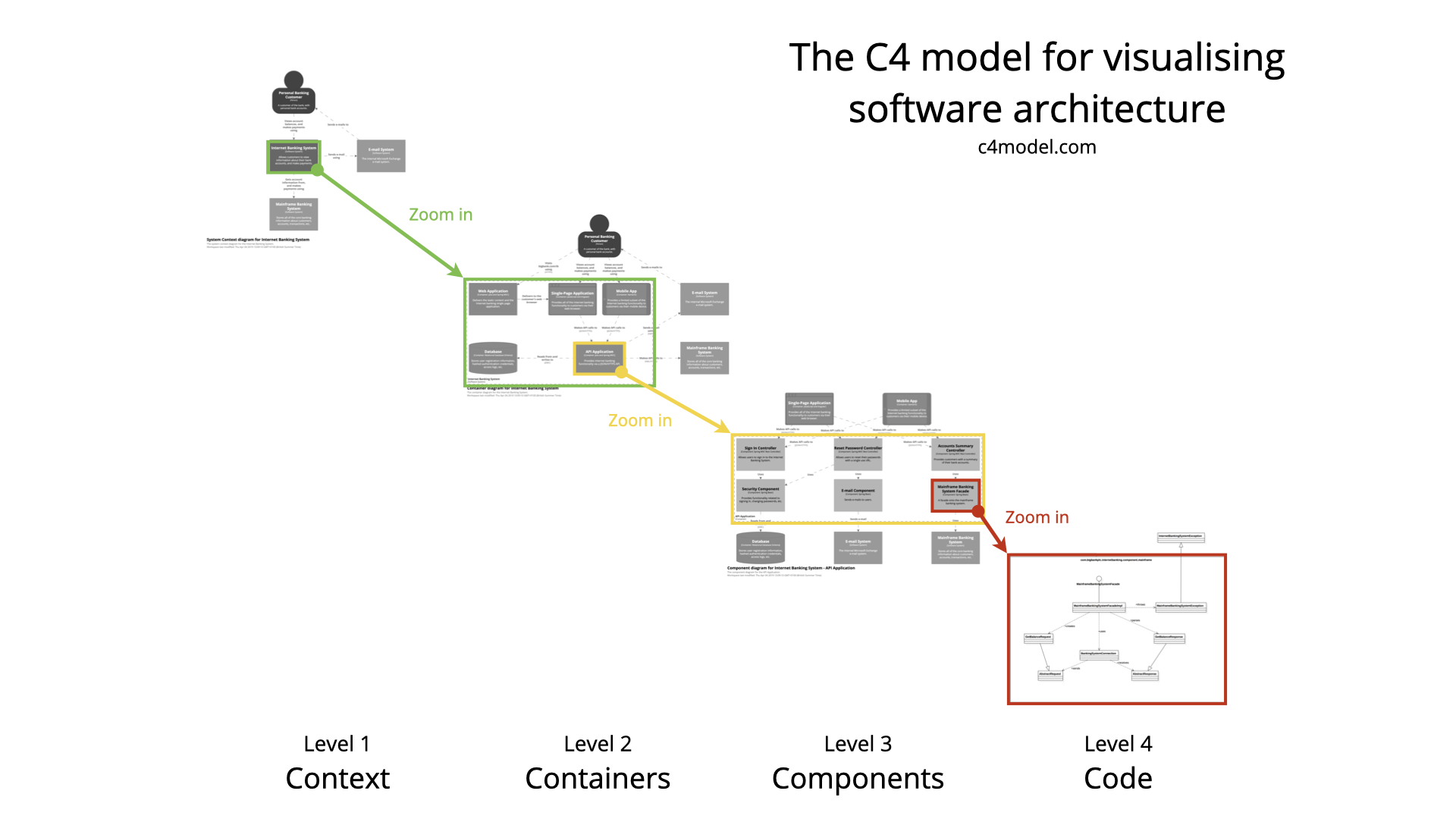
Different levels of zoom allow you to tell different stories to different audiences.
Hover your mouse over the diagram, find elements with a , and double-click to zoom-in.
In order to create these maps of your code, we first need a common set of abstractions to create a ubiquitous language that we can use to describe the static structure of a software system. A software system is made up of one or more containers (applications and data stores), each of which contains one or more components, which in turn are implemented by one or more code elements (classes, interfaces, objects, functions, etc). And people may use the software systems that we build.
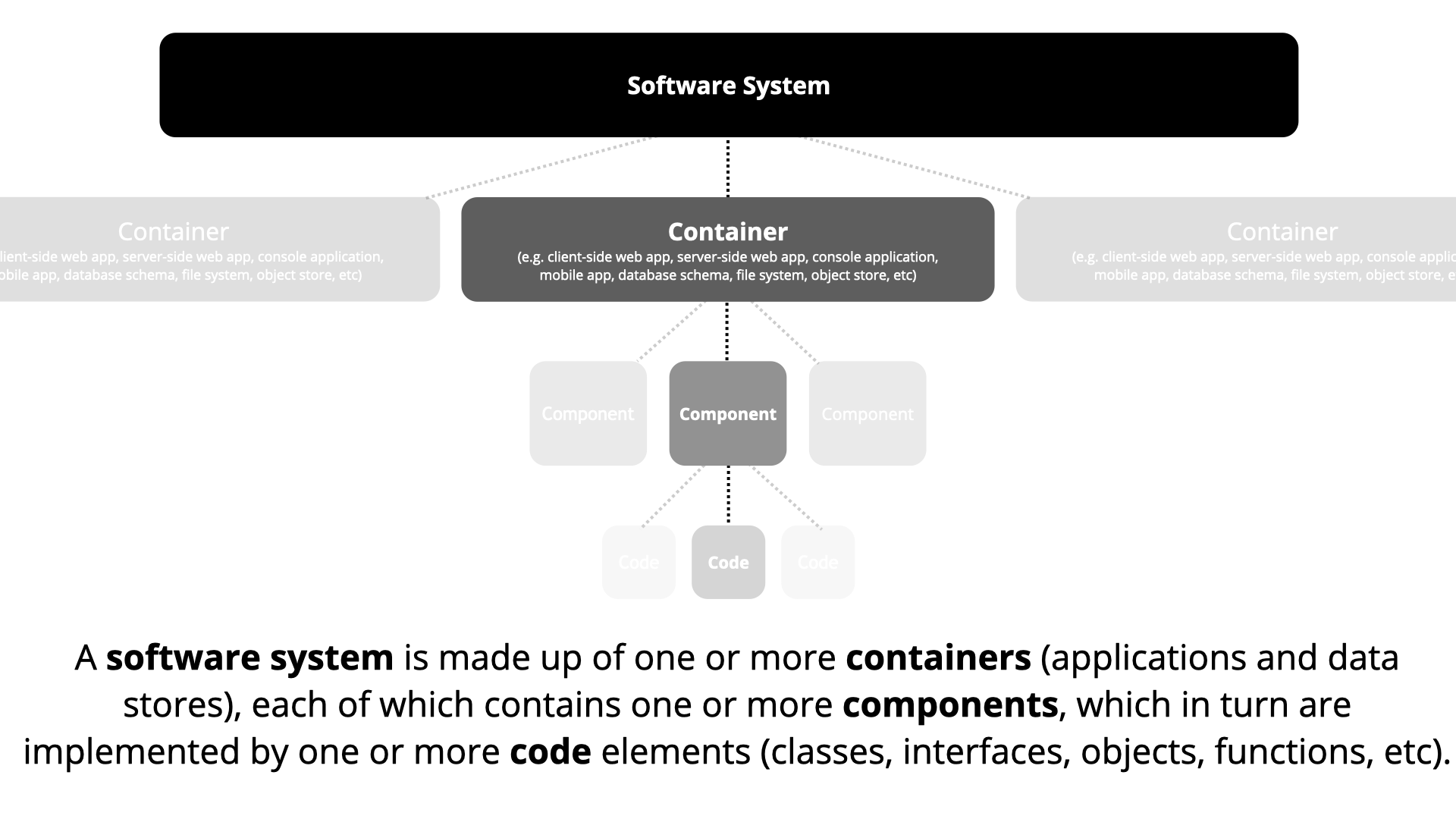
A person represents one of the human users of your software system (e.g. actors, roles, personas, etc).
A software system is the highest level of abstraction and describes something that delivers value to its users, whether they are human or not. This includes the software system you are modelling, and the other software systems upon which your software system depends (or vice versa).
Unfortunately the term "software system" is the hardest of the C4 model abstractions to define, and this isn't helped by the fact that each organisation will also have their own terminology for describing the same thing, typically using terms such as "application", "product", "service", etc. One way to think about it is that a software system is something a single software development team is building, owns, has responsibility for, and can see the internal implementation details of. Perhaps the code for that software system resides in a single source code repository, and anybody on the team is entitled to modify it. In many cases, the boundary of a software system will correspond to the boundary of a single team. It may also be the case that everything inside the boundary of a software system is deployed at the same time.
Not Docker! In the C4 model, a container represents an application or a data store. A container is something that needs to be running in order for the overall software system to work. In real terms, a container is something like:
The word "component" is a hugely overloaded term in the software development industry, but in this context a component is a grouping of related functionality encapsulated behind a well-defined interface. If you're using a language like Java or C#, the simplest way to think of a component is that it's a collection of implementation classes behind an interface. Aspects such as how those components are packaged (e.g. one component vs many components per JAR file, DLL, shared library, etc) is a separate and orthogonal concern.
An important point to note here is that all components inside a container typically execute in the same process space. In the C4 model, components are not separately deployable units.


A System Context diagram is a good starting point for diagramming and documenting a software system, allowing you to step back and see the big picture. Draw a diagram showing your system as a box in the centre, surrounded by its users and the other systems that it interacts with.
Detail isn't important here as this is your zoomed out view showing a big picture of the system landscape. The focus should be on people (actors, roles, personas, etc) and software systems rather than technologies, protocols and other low-level details. It's the sort of diagram that you could show to non-technical people.
Scope: A single software system.
Primary elements: The software system in scope.
Supporting elements: People (e.g. users, actors, roles, or personas) and software systems (external dependencies) that are directly connected to the software system in scope. Typically these other software systems sit outside the scope or boundary of your own software system, and you don't have responsibility or ownership of them.
Intended audience: Everybody, both technical and non-technical people, inside and outside of the software development team.
Recommended for most teams: Yes.


Once you understand how your system fits in to the overall IT environment, a really useful next step is to zoom-in to the system boundary with a Container diagram. A "container" is something like a server-side web application, single-page application, desktop application, mobile app, database schema, file system, etc. Essentially, a container is a separately runnable/deployable unit (e.g. a separate process space) that executes code or stores data.
The Container diagram shows the high-level shape of the software architecture and how responsibilities are distributed across it. It also shows the major technology choices and how the containers communicate with one another. It's a simple, high-level technology focussed diagram that is useful for software developers and support/operations staff alike.
Scope: A single software system.
Primary elements: Containers within the software system in scope.
Supporting elements: People and software systems directly connected to the containers.
Intended audience: Technical people inside and outside of the software development team; including software architects, developers and operations/support staff.
Recommended for most teams: Yes.
Notes: This diagram says nothing about clustering, load balancers, replication, failover, etc because it will likely vary across different environments (e.g. production, staging, development, etc). This information is better captured via one or more deployment diagrams.


Next you can zoom in and decompose each container further to identify the major structural building blocks and their interactions.
The Component diagram shows how a container is made up of a number of "components", what each of those components are, their responsibilities and the technology/implementation details.
Scope: A single container.
Primary elements: Components within the container in scope.
Supporting elements: Containers (within the software system in scope) plus people and software systems directly connected to the components.
Intended audience: Software architects and developers.
Recommended for most teams: No, only create component diagrams if you feel they add value, and consider automating their creation for long-lived documentation.

Finally, you can zoom in to each component to show how it is implemented as code; using UML class diagrams, entity relationship diagrams or similar.
This is an optional level of detail and is often available on-demand from tooling such as IDEs. Ideally this diagram would be automatically generated using tooling (e.g. an IDE or UML modelling tool), and you should consider showing only those attributes and methods that allow you to tell the story that you want to tell. This level of detail is not recommended for anything but the most important or complex components.
Scope: A single component.
Primary elements: Code elements (e.g. classes, interfaces, objects, functions, database tables, etc) within the component in scope.
Intended audience: Software architects and developers.
Recommended for most teams: No, particularly for long-lived documentation because most IDEs can generate this level of detail on demand.


The C4 model provides a static view of a single software system but, in the real-world, software systems never live in isolation. For this reason, and particularly if you are responsible for a collection/portfolio of software systems, it's often useful to understand how all of these software systems fit together within a given enterprise, organisation, department, etc. Essentially this is a map of the software systems within the chosen scope, with a C4 drill-down for each software system of interest.
From a practical perspective, a system landscape diagram is really just a system context diagram without a specific focus on a particular software system.
Scope: An enterprise/organisation/department/etc.
Primary elements: People and software systems related to the chosen scope.
Intended audience: Technical and non-technical people, inside and outside of the software development team.


A dynamic diagram can be useful when you want to show how elements in the static model collaborate at runtime to implement a user story, use case, feature, etc. This dynamic diagram is based upon a UML communication diagram (previously known as a "UML collaboration diagram"). It is similar to a UML sequence diagram although it allows a free-form arrangement of diagram elements with numbered interactions to indicate ordering.
Scope: A particular feature, story, use case, etc.
Primary and supporting elements: Your choice - you can show software systems, containers, or components interacting at runtime.
Intended audience: Technical and non-technical people, inside and outside of the software development team.
Notes: Feel free to use a UML sequence diagram if you prefer that visual style.



A deployment diagram allows you to illustrate how instances of software systems and/or containers in the static model are deployed on to the infrastructure within a given deployment environment (e.g. production, staging, development, etc). It's based upon a UML deployment diagram.
A deployment node represents where an instance of a software system/container is running; perhaps physical infrastructure (e.g. a physical server or device), virtualised infrastructure (e.g. IaaS, PaaS, a virtual machine), containerised infrastructure (e.g. a Docker container), an execution environment (e.g. a database server, Java EE web/application server, Microsoft IIS), etc. Deployment nodes can be nested.
You may also want to include infrastructure nodes such as DNS services, load balancers, firewalls, etc.
Feel free to use icons provided by Amazon Web Services, Azure, etc to complement your deployment diagrams . just make sure any icons you use are included in your diagram key/legend.
Scope: One or more software systems within a single deployment environment (e.g. production, staging, development, etc).
Primary elements: Deployment nodes, software system instances, and container instances.
Supporting elements: Infrastructure nodes used in the deployment of the software system.
Intended audience: Technical people inside and outside of the software development team; including software architects, developers, infrastructure architects, and operations/support staff.
The C4 model is notation independent, and doesn't prescribe any particular notation. As a starting point though, a simple notation that works well on whiteboards, paper, sticky notes, index cards and a variety of diagraming tools is as follows.